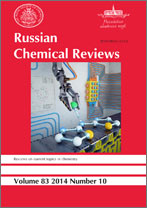|
This article is cited in 84 scientific papers (total in 84 papers)
Structural and dynamic properties of tetrahydroborate complexes
V. D. Makhaev
Institute of Problems of Chemical Physics, Russian Academy of Sciences, Chernogolovka, Moscow region
Abstract:
Data on the structures of tetrahydroborate complexes from X-ray diffraction analysis, neutron and electron diffraction, and IR and NMR spectroscopy are considered. It is shown that, in addition to the diversity of stabilising ligands, complexes of Group III and IV transition metals are characterised by diverse types of coordination of terminal (η1, η2 and η3) and bridging (between neutral molecular units) tetrahydroborate groups. Compounds with BH4 groups with different denticities can be found among these complexes. Most tetrahydroborates of these metals in the oxidation states +3, +4 comply with the principle of maximum occupancy of the coordination sphere. Tetrahydroborates of Group III and IV metals exhibit clear-cut stereochemical non-rigidity (fluxionality): the protons of the BH4 ligand are equivalent on the NMR time scale. Group I and V–VIII transition metals mainly form η2-complexes, which are stereochemically much more rigid than complexes of Group III and IV metals. It is suggested that electronic configuration of the central atom is the crucial factor determining different structures and stereochemical behaviours of the tetrahydroborate complexes. Data on the structures and properties of post-transition and s-element tetrahydroborates are also consistent with this assumption. The bibliography includes 248 references.
Received: 09.03.2000
Citation:
V. D. Makhaev, “Structural and dynamic properties of tetrahydroborate complexes”, Usp. Khim., 69:9 (2000), 795–816; Russian Chem. Reviews, 69:9 (2000), 727–746
Linking options:
https://www.mathnet.ru/eng/rcr1539https://doi.org/10.1070/RC2000v069n09ABEH000580 https://www.mathnet.ru/eng/rcr/v69/i9/p795
|


| Statistics & downloads: |
| Abstract page: | 157 |
|





 Contact us:
Contact us: Terms of Use
Terms of Use
 Registration to the website
Registration to the website Logotypes
Logotypes









